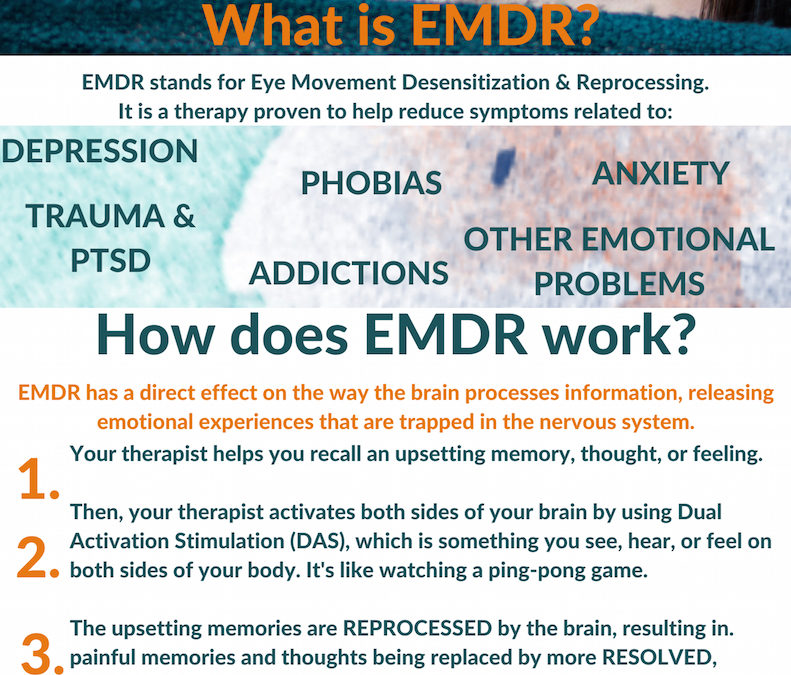I am excited to be able to offer EMDR to my clients. Before explaining what it is, it’s important to review what trauma is.
In general, trauma is a disturbing event that diminishes your sense of control. This can range from something horrific and life-threatening, such as being raped, to something heartbreaking and life-changing, such as a felt sense that you’re not good enough or worthwhile of love.
Dr. Gabor Mate explains trauma in a beautiful way. He said:
“The essence of trauma is that, as a result of the overt abuse or neglect, or because of the relational trauma, we lose the connection to our essence. That’s what the trauma is. The trauma is not what happened; the trauma is not that I was raped, the trauma is not that I was abandoned, the trauma is not that I was hit, the trauma is not that my parents didn’t know how to listen to me. That’s not the trauma; the trauma is that, as a result of that, I lost the connection to myself. Hence, I lost the connection to my essential qualities: my joy, my vitality, my clarity, my wisdom, my power, my strength, my courage. That’s the trauma!” -Dr. Gabor Mate
Because we are human, most of us have experienced trauma, or a disconnection to our essence, in some way.
There are a few different ways to treat trauma. I’m trained in EMDR, which stands for Eye Movement Desensitization and Reprocessing. EMDR is a little hard to explain, but don’t let that scare you. Even though it’s hard to explain, it’s the most researched treatment for PTSD.
- In one study it was shown to be more effective at treating PTSD and depression than Prozac.
- EMDR has been successful for treating many problems and traumas such as: PTSD, anxiety, panic attacks, depression, phobias, grief, abuse, chronic pain, and addictions.
- EMDR is different than talk therapy – in fact it involves a whole lot less talking and a lot more of you bravely holding the traumatic memory while letting your body process through the memory in a more adaptive way.
When we experience a trauma, the brain stores the disturbing event in a memory network in a way that isolates it and prevents it from connecting with more useful, adaptive information. So instead of learning and resolving the memory, the old material just keeps getting triggered over and over again.
In another part of your brain, in a separate network, is most of the information you need to resolve it. It’s just prevented from linking up to the old stuff. Once we start processing with EMDR, the two networks can link up and new information can come to mind and resolve the old problems.
Once the new connections are made, the negative emotions should diminish. I know it can be scary to sit with these old traumatic memories, so one thing I want you to know is that by doing EMDR, we aren’t adding anything negative to what’s already there. Instead, we are opening up some neural pathways that will allow the tough negative stuff to drain out and diminish. This will help you resolve the memory. EMDR will not erase the memory; rather you will be able to remember the story without all the emotional charge that was distressing before the treatment.
The weird part about EMDR is that it uses something we call the Dual Attention Stimulation, which we call DAS. DAS is a little weird, but it involves alternating stimulation on both sides of your body. This can be done by following my fingers, holding pulsers in both hands, or hearing small sounds alternating between both ears.
Researchers are still studying this, but so far, our best guess is that using DAS elicits an orienting response, which means that the DAS will immediately have a physiological and behavioral change as your body responds to the stimulation. This is really just a fancy way of saying that DAS can cause you to deeply relax, which will help those adaptive connections to happen.
When you’re doing EMDR, sometimes it can be a bit intense as you face these old memories, because you’ve been working so hard to not face it for all of these years. But, think of it this way — the old stuff is effecting you in so many different ways every day —once we process through the old stuff, while some unpleasant sensation may arise during EMDR, that is a sign that the old material is leaving the nervous system.
The bottom line is that EMDR is one of the most research validated techniques to process trauma. Clients like it because it is quick, effective, body and brain-based (doesn’t require a ton of talking), and comprehensive with a success rate of 80-90%.


